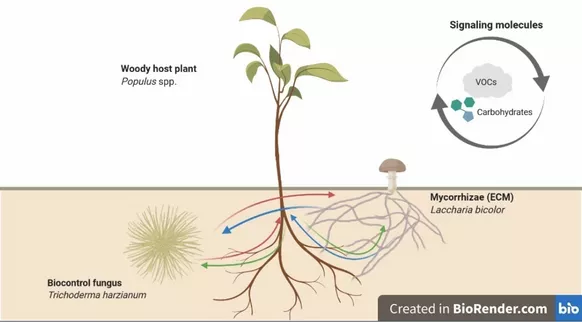Understanding the molecular traits of multi-organismic communication in beneficial tree-microbe associations
| The application of plant-beneficial microorganisms as bio-fertiliser has gained traction in recent years, as both agriculture and forestry are facing the challenges of poor soils and climate change. This includes the fungal genus Trichoderma, which antagonizes plant-pathogenic fungi and can function as biocontrol agent. However, the rhizosphere also contains other plant-beneficial fungi, such as mycorrhizal fungi. While plants would benefit from both, the mycotrophic nature of Trichoderma could interfere with the symbiotic interactions between plants and mycorrhiza. In this project, we aim to understand the communication between a representative model system of these partners including a woody host plant (poplar), an ectomycorrhizal fungus (Laccaria bicolor), and Trichoderma harzianum as a per se plant-beneficial but potentially antagonistic fungus. Particularly the role of volatile organic compounds (VOCs) and carbohydrates in the communication of the partners are of central interest as well as the molecular signalling cascades that are involved. | |
| Duration | 2020-2023 |
| Editing | Pia Stange (TUM-HFM), Prasath Sivaprakasam (HMGU), Dr. Tanja Karl (TUM-HFM), Dr. Maaria Rosenkranz (HMGU), Prof. Dr. J. Philipp Benz (TUM-HFM) |
| Funding | DFG (BE 6069/4-1) |

|
|
| Partner | Helmholtz Zentrum München - Deutsches Forschungszentrum für Gesundheit und Umwelt - Research Unit Environmental Simulation (EUS) |
| Link to the project site of the partners: https://www.helmholtz-muenchen.de/eus/research/biology-of-volatile-organic-compounds-vocs/dfg-poplar-communication/index.html | |
Publications
- Guo Y, Jud W, Weikl F, Ghirardo A, Junker RR, Polle A, Benz JP, Pritsch K, Schnitzler JP, Rosenkranz M. (2021) Volatile organic compound patterns predict fungal trophic mode and lifestyle. Communications Biology (accepted MS)
- Guo Y, Jud W, Ghirardo A, Antritter F, Benz JP, Schnitzler JP, Rosenkranz M. (2020) Sniffing fungi – phenotyping of volatile chemical diversity in Trichoderma species. New Phytologist 227: 244–259, doi: 10.1111/nph.16530
- Guo Y, Ghirardo A, Weber B, Schnitzler JP, Benz JP, Rosenkranz M. (2019) Trichoderma species differ in their volatile profiles and in antagonism towards ectomycorrhiza Laccaria bicolor. Frontiers in Microbiology, 10: 891. doi: 10.3389/fmicb.2019.00891
